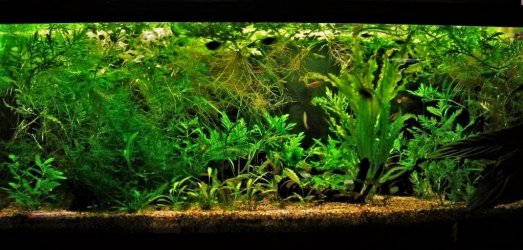The advice on the fish store sheet is false, or at the least misleading. Why would anyone want to raise the GH for soft water fish that occur in very soft waters, rarely if ever as high as even 1 degree? A rhetorical question really, the answer is, no one. And raising the KH is another issue...who says fish need this? All the tropical fish in South America live in very soft water generally wiyth a very low KH, and an acidic pH. You have soft water fish mentioned, so give them the water they need, which fortunately is what comes out of your tap. Soft water fish need soft water. The pH should lower on the acidic side. Do not mess with the GH, nor the KH as that will likely lead to conflicting pH. If it is rising in the tank, the usual reason is a calcareous substrate or calcareous rock. Whay is the substrate composed of, and are there any rocks in the tank?
For over 30 years I have kept tanks of fish in my tap water which is 7ppm, less than half of 1 degree, GH, and zero KH.
Do not use Neutral regulator, or any other chemical substances. The fish in post #1 are soft water species. The initial post was about your fish losing colour and dying...these substances/additives certainly do not help.
0 kh? lol?!? that's a ph crash right there...
as for messing with gh/kh -> ph......everyone that uses RO does it...
anyone that uses chemicals/dechlorinators does it...
anyone that does water changes over 50% does it...
fish in south america actually have fluctuating ph/gh/kh
ph 6.5 - 7.5
gh/kh 6-8 which would be around 120ppm
the screenshots of the fish & feather the OP provided on how to fix his water are actually 100% correct and is exactly what I told him before..
raise KH to stabilize ph
root tabs which will provide the minerals and nutrients for his plants to grow...
and he can SLOWLY add crushed coral until he gets the desired kh of 7 which would be around 125ppm
at 6-8gh in south america like xio xingu where plecos/discus are famously from....
I find that there's been a lot of conflicting advice of what his issue is...
he simply has to fix his water...nothing more...nothing less..
----------------------------------------------------------------------------------------------------------------------------------
1. put water in a bucket for 7 days (use this water to change water weekly without the need for chlorine removers etc...)
2. shove a few root tabs in your substrate for minerals/nutrients for plants and some gh increase...
3. add a little crushed coral on every water change until he gets the desired kh of 6-8 to match his fish
----------------------------------------------------------------------------------------------------------------------------------
problem fixed...
if anyone has a better suggestion on a way to fix his issue let it be known.....
I think there's been lots of contradicting advice on here when he only needs to do 3 simple steps...
suggesting fish live in 0 kh?!?!?!? and that fish in south america come from very soft water? on which planet?!?








